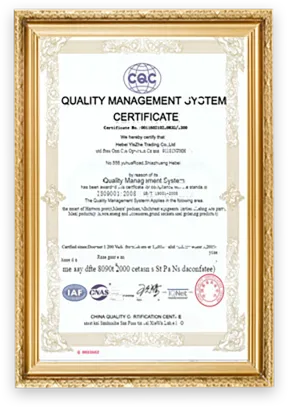Aug . 12, 2024 09:42 Back to list
Innovative Gabion Basket Retaining Wall Design for Effective Erosion Control and Landscape Enhancement
Gabion Basket Retaining Walls Durable and Aesthetic Solutions for Erosion Control
In the realm of civil engineering and landscaping, managing soil erosion and stabilizing slopes is a critical concern. One increasingly popular solution is the gabion basket retaining wall, an innovative structure that marries functionality with aesthetics. Through the use of wire mesh baskets filled with stones or other materials, gabion walls offer numerous benefits, making them an ideal choice for a variety of applications.
What Are Gabion Baskets?
Gabion baskets are rectangular wire cages, typically made from galvanized steel or stainless steel, designed to hold rocks, concrete rubble, or other fill materials. These baskets are stacked to form retaining walls that provide structural support and prevent soil erosion. The flexibility of the wire mesh allows for slight movements in the structure without compromising its integrity, making gabion walls suitable for areas with shifting soil conditions.
Benefits of Gabion Basket Retaining Walls
1. Erosion Control One of the primary functions of gabion basket walls is to control erosion. As water flows over soil, it can wash away essential nutrients and stability. By acting as a barrier, gabion walls reduce the velocity of water and allow sediment to settle, thus protecting adjacent land from being eroded.
2. Aesthetic Appeal Gabion walls can be visually appealing, blending harmoniously into natural landscapes. The use of natural stones allows for a variety of colors and textures, providing an organic look that can enhance the beauty of gardens, parks, and rustic properties. Additionally, plants can be incorporated around and within the gabions to create a more integrated aesthetic.
gabion basket retaining wall

3. Environmentally Friendly Gabion baskets are often filled with locally sourced stone or recycled materials, making them a sustainable choice for construction. Their permeability allows for natural drainage, reducing the risk of water pooling and further erosion, which can be detrimental to landscapes.
4. Cost-Effectiveness Compared to traditional concrete retaining walls, gabion baskets are typically more economical. The materials required for filling—such as natural stones—are often less expensive and more readily available than cast concrete. Moreover, the installation process is often quicker and requires less heavy machinery, leading to reduced labor costs.
5. Versatility Gabion walls can be adapted to various situations. They can be used for terracing, road construction, shoreline protection, and even as decorative features in gardens. Their modular nature allows for easy expansion or modification, making them a versatile option for any project.
Installation Process
The installation of a gabion basket retaining wall begins with site preparation, which includes clearing the area and ensuring a stable foundation. After the foundation is laid, the gabion baskets are assembled and filled with chosen materials. The baskets can be stacked in tiers to create walls of desired height. It’s crucial that during installation, the baskets are properly aligned and secured to ensure stability.
Conclusion
Gabion basket retaining walls present a compelling solution for erosion control and slope stabilization, offering durability, cost-effectiveness, and aesthetic benefits. Their eco-friendly nature and versatility make them suitable for a wide range of applications, from residential landscaping to major civil engineering projects. As more individuals and communities recognize the advantages of gabion walls, we can expect to see a continued rise in their popularity as sustainable infrastructure solutions. Embracing this innovative approach not only enhances the landscape but also contributes to the long-term health of our environment.
-
Weather Resistance Properties of Quality Roofing Nails
NewsAug.01,2025
-
How Galvanised Iron Mesh Resists Corrosion in Harsh Environments
NewsAug.01,2025
-
Creative Landscaping Uses for PVC Coated Wire Mesh Panels
NewsAug.01,2025
-
Common Wire Nail Dimensions and Their Specific Applications
NewsAug.01,2025
-
Choosing the Right Welded Wire Sheets for Agricultural Fencing
NewsAug.01,2025
-
Anti - Climbing Features of Razor Wire Barriers
NewsAug.01,2025









